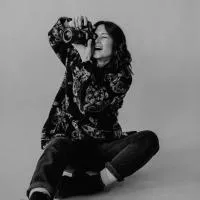Contents
It depends! OK, OK, don’t yawn :-) Let me explain.
Single-page vs multi-page (“regular”) websites
Most of the time, photographers need to display multiple galleries/portfolios, as well as more pages about their services, past clients, testimonials, etc. It would be really hard to compact this all into a single page.
But if your website is just a small “online business card” to give people a quick idea of your services and to ask them to contact you, then yes, by all means, go with a single-page website.
The navigation items will just be quick-jump links to scroll people to the various sections on the page. I’ve often seen single-page websites that have everything on the page except for the blog area (which just links to a separate page).
It’s basically a simple linear experience (as users scroll down), with a clear beginning, middle, and end.

It obviously all depends on the amount of content you have. But if you can “get away” with a single-page site, then that’s great. Simplicity is good.
Single-page websites are also useful if you want to branch out to other niches, and you just need to put something online to promote your new service. And it might make sense to keep it separate from your existing online presence, so you get a new domain name and start thinking about a new website.
Let’s talk sales funnels
Yes, we’re taking out the business lingo now. Here’s what business funnels are and how to work on them.
Since your website’s goal probably is to convert visitors into clients (whether that’s wanting them to hire you or to buy your images), I’ve always recommended guiding people through your website, through your most important pages, eventually leading them to the destination (Contact page or a purchase page).
If you have a regular multi-page website, you do that by using call-to-action buttons.
With a one-page website, that all becomes easier, people simply need to scroll down to see what you have to offer, eventually reaching your contact form (which sits at the end of the page).
The sales funnel basically becomes the “scroll depth”, how much visitors scroll through your page. This is more difficult to track in Google Analytics, but you can use a plugin like this to help you out.
SEO considerations
This should be obvious. Less content => less stuff for Google to index => less likelihood of ending up on the first page of relevant search results.
Since you only have a single page to work with, you can only optimize for one or two main keywords/phrases.
And because single-page sites are often used just for “brand awareness” and to have a verifiable online presence, it’s fine.
The majority of your business probably comes from referrals anyway – not from showing up on the first page of Google.
Perceived performance
Single-page websites are simpler overall, but I would argue that they load slower because they usually contain a lot more content.
Whereas a regular website has a simpler homepage, which loads faster.
But if you consider the whole browsing experience (just scrolling on a single-page site vs loading separate pages on a regular site), then yes, a single-page site is much easier to use. That’s the main advantage of having a single-page website: the navigation menu contains links to the various sections on a page. When you click on a menu item, the page simply scrolls down immediately (instead of having to wait for a new page to load). So the “perceived” performance is better.
A single-page website is just a starting point
You can start out with a single-page website and then expand in the future.
For example, HeadshotSquad used to be just a simple one-page website promoting their business portrait service. As their business expanded (to cover beauty and fitness images), they simply added those to the navigation menu, linking to separate pages. But the website used to be exactly what’s now on the homepage, so you can get an idea of what can be achieved with such a site.
So there’s no reason why you can’t start off with a single-page site, and then later add separate pages (that promote new services and target different keywords/phrases).
Separate pages can also provide more info for people who want to dive deeper into your content: for example, the homepage has just a short “best-of” portfolio of images, with a button to view more, which leads to a separate gallery page. Or if you’re promoting wedding services on your already-crowded homepage, you can just link to a separate page to promote engagement shoots.
Further reading
- Single-Page vs. Multi-page UI Design: Pros & Cons
- Single Page Websites | Bad News For SEO?
- Discover single-page vs. multipage design: pros & cons
- SEO Single Page vs. Multiple Page WordPress Themes
- 8 Reasons Why Pageless Design is the Future of the Web
Conclusion
In most cases, you need a full-featured multi-page website. That’s the norm.
A single-page website might be a great fit for you only if…
- your content fits on a single page (don’t worry, people scroll if the content is worth it)
- you’re promoting a single specific service (otherwise it’s a bit too much)
- you don’t need eCommerce functionality or a blog
- you just want an “online business” card (a bio, a short portfolio, some info about your services, and your contact info)
The deciding factor is content, that’s your compass. Choose a website structure that best leverages your content.














